- Here Come the Tomatoes
With this year’s warm weather, we’ll be picking things from the garden a lot earlier than most years. I’m often late getting things started, but I did a good job of getting the tomatoes, peppers, and cole crops into the ground before the end of May. The early start coupled with the hot weather is giving us veggies in July that we normally don’t start harvesting until August. All in all, it appears we will have a good harvest as we go into late summer and fall.
This small bed holds most of the hot peppers. In the foreground are Serranos and behind them are cayennes and some various Asian hot peppers. Judy likes to freeze Serrano peppers. She should have plenty. The cayennes are exceptionally large this year and the pepper plants, in general, are taller than what I usually get.
In front of the asparagus is my second pepper bed. The small plants in front are Poblanos. They are loaded with fruit. The rest of the bed contains various sweet peppers. I have a lot of Nardellos, the American-Italian heirloom that we like a lot. Those too are very heavy with peppers. Behind and to the right of the peppers are two potato beds, one red and one yellow. Both are doing well. I’ve already snitched a few red ones.
The sweet potatoes are loving the heat. I can’t see what’s going on down below the vines, but I’m hoping for the best. I’ve been covering the vines with ag fabric to keep the deer from munching on them. The deer love sweet potato leaves.
We ate our first sweet corn, yesterday, I only have one bed this year. Most years I get two beds planted. I’m inter-planting the corn with two heirloom pole beans that have traditionally been grown using corn stalks for trellises. One bean is called Turkey Craw, the other is Missouri Wonder. The beans in the corn have a long way to go, but they look just fine.
Here is my main bean crop, with leeks in the bed to the left, tomatoes, tomatillos, and eggplants in the bed to the right of the beans, and onions to right of the tomatoes. You can see another bed of tomatoes in the back right and in front of those are two blue barrel rings holding some fingerling potatoes which I just planted. It’s my plan to keep adding soil to the rings as the potatoes grow to try to get a larger yield. I haven’t done this before, so we’ll have to see if it works.
The pole beans in the front of the picture are trellised onto four tripods. Behind them in the same bed are bush beans. They are just flowering but I expect good production. Last year we had a similar size set up that got somewhat eaten by deer and we still had a huge harvest. I expect a lot more beans this year. We are getting Japanese beetles in the beans, but I’m able to keep ahead of much damage by cleaning off the beetles using my funnel trap, which you can read about here.
I went overboard with the eggplants, I just didn’t have the heart to cull out the nice seedling starts, so we have 16 eggplants. I normally grow four to six. They are looking great. We’re trying to figure out the best way to freeze them – any suggestions?
Here are three good looking cabbages in one of two beds dedicated to cole crops. The other bed is under ag fabric. Most of this bed was used to grow kohlrabi and we’ve already harvested about half the planting. Judy talks about using kohlrabi in her recipe post. I’ve been spraying my coles with a neem oil, soap, and seaweed mixture and that seems to have really made a huge difference on damage from cabbage moths. The moth eggs hatch but the caterpillars die when they eat leaves containing neem oil. While the neem spray hasn’t done much for the squash it seems very effective in the coles.
Here is our second zucchini. We picked the first, yesterday. We’ll have lots, I’ve got five healthy plants. The squash, melons, cukes, and zukes all got a late start. While the zucchini are doing well I’m really having some major problems both with cucumber beetles and squash vine borers. I’m definitely going to lose a few squash and melon plants. I always tell people starting out in gardening to grow a lot of different stuff. Some will always succeed and even if you lose an entire crop of one vegetable you’ll still have plenty of the others.
These Mammoth Sunflowers are already ten feet tall and they aren’t done growing. Their stalks are like tree trunks.
Unfortunately, this could be a year without basic root crops. No carrots or beets in the ground, yet. It’s not too late for either for a fall crop if I can get to it, but in any case, we’ll get plenty from the garden, this year.

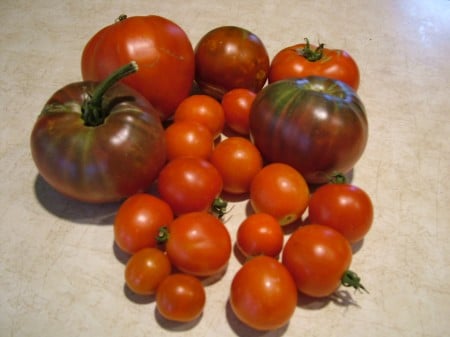

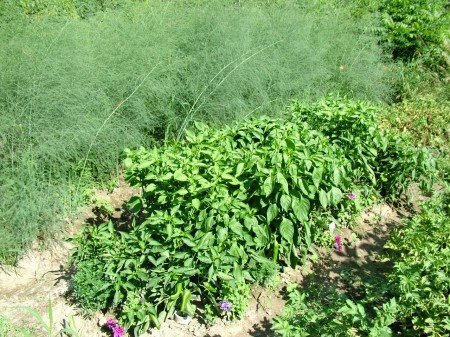


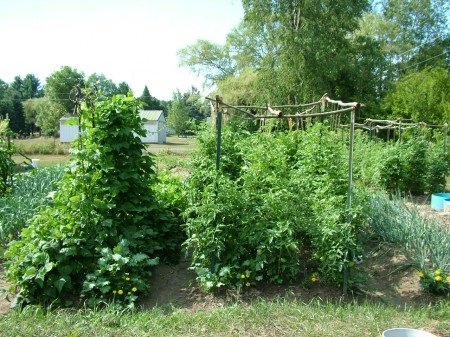
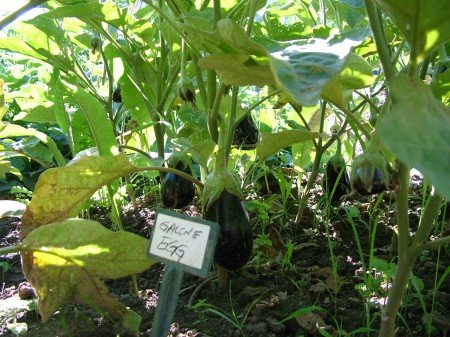

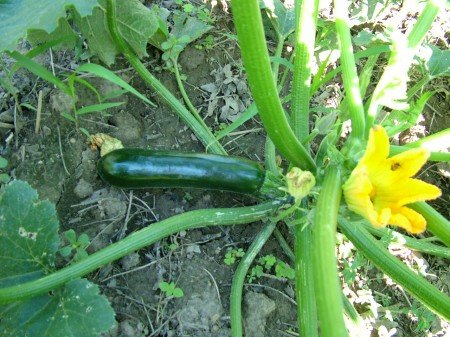

Hi, found Alton Brown’s description of ‘purging’- salting and drying eggplant slices- in a discussion on freezing eggplant here: http://community.cookinglight.com/showthread.php?t=77177
Thanks, Michele. I will give the eggplant purging a try this year. I’ve also had good luck with a simple eggplant pasta sauce. Just saute eggplant chunks with freshly minced garlic in olive oil. Add enough chopped tomatoes to fill the frying pan, salt and pepper to taste, and simmer about 30 minutes or until thickness desired. Cool and freeze.